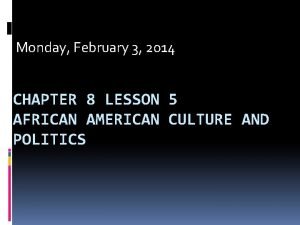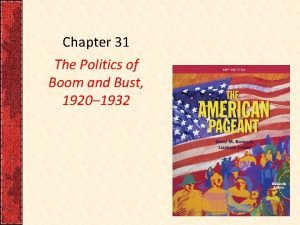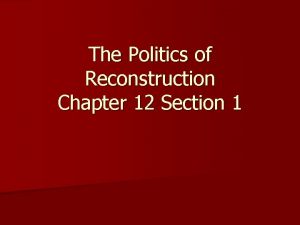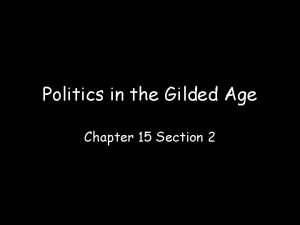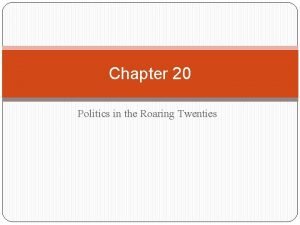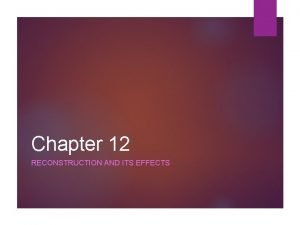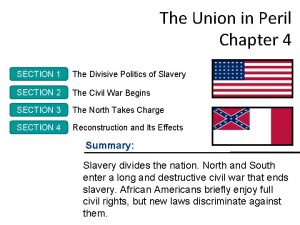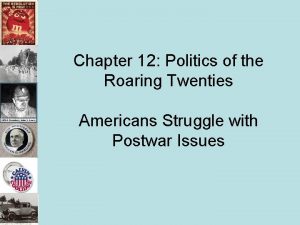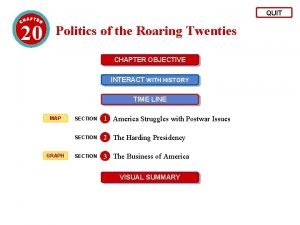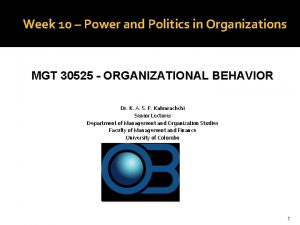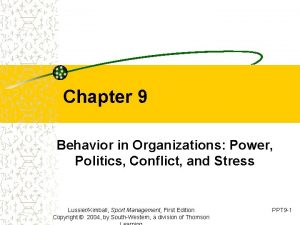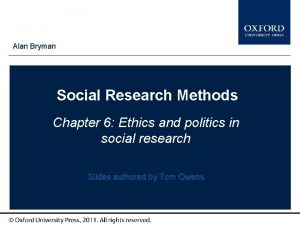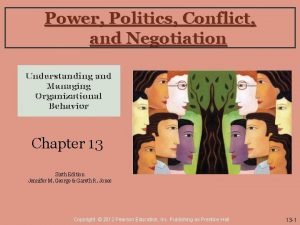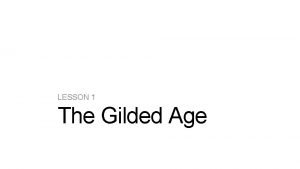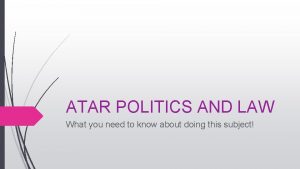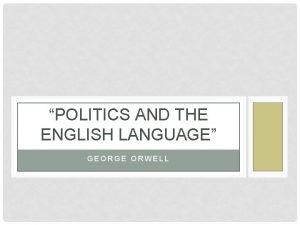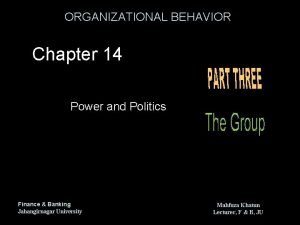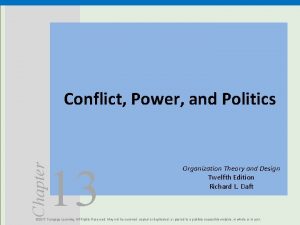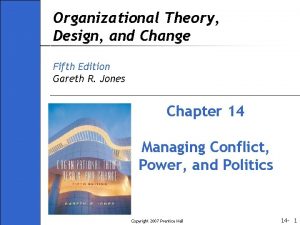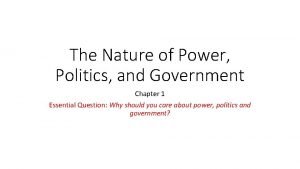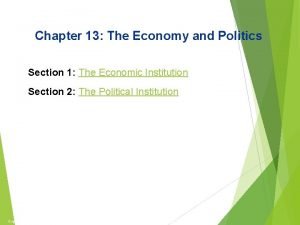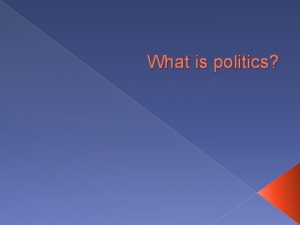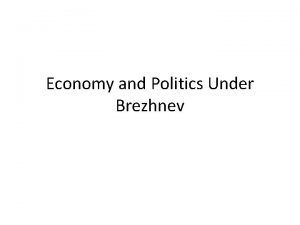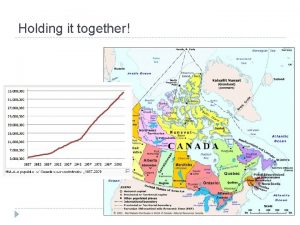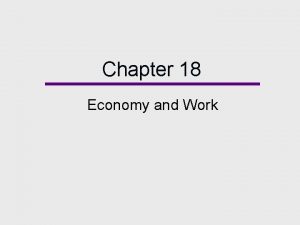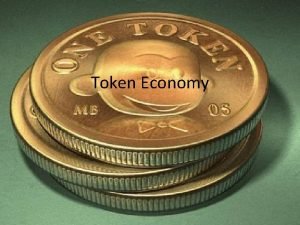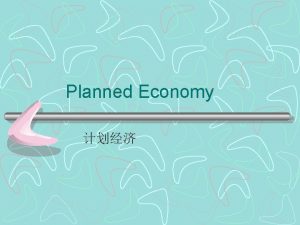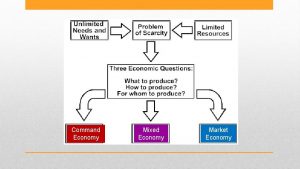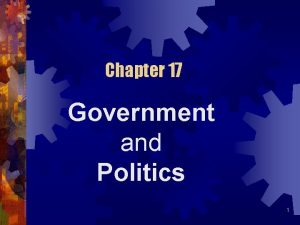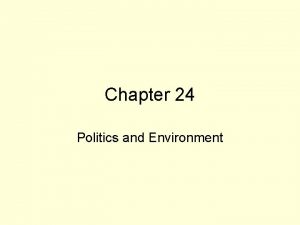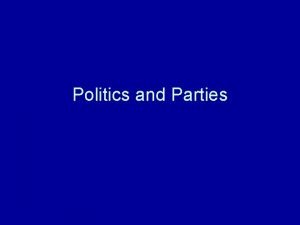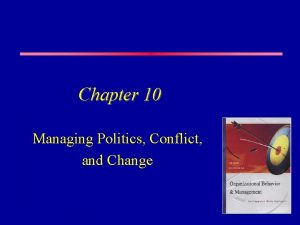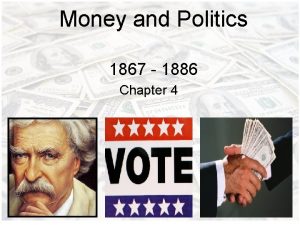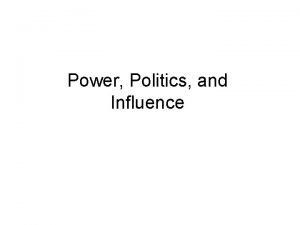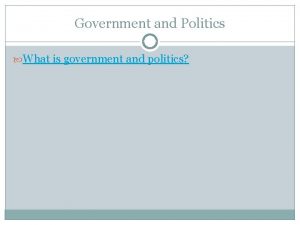Chapter 13 Politics and the Economy Chapter Outline
























































- Slides: 56

Chapter 13 Politics and the Economy

Chapter Outline § Introducing Politics and the Economy § Power and Politics § Power and the State § Who Governs? Models of U. S. Democracy § Individual Participation in U. S. Government § Modern Economic Systems § The U. S. Economic System § Work in the United States § Where This Leaves Us

Introducing Politics and the Economy § Politics and the economy are two separate social institutions, but they are interwoven. § Both should be considered when answering questions such as: ◦ How do people earn their living? ◦ Why are wages so much higher in some types of work and in some countries than others? ◦ How do government leaders get elected, deposed, or assassinated?

Power and Politics Coercion §The exercise of power through force or the threat of force is coercion. Authority §Power supported by norms and values that legitimate its use is authority. 1. Traditional Authority – the right to make decisions for others based on the sanctity of timehonored routines 2. Charismatic Authority – the right to make decisions based on perceived extraordinary personal characteristics 3. Rational-Legal Authority – the right to base decisions on rationally established rules

Power and Politics Traditional Authority Traditional authority, like that enjoyed by King Mohamed VI of Morocco, exists when an individual’s right to make decisions for others is widely accepted based on time-honored beliefs. Monarchies and patriarchies are classic examples. In America in the 1950 s, husbands had the authority in the family (patriarchy). Even today, traditional families hold to this.

Power and Politics Combining Bases of Authority: § An elected official who adds charisma to his rational-legal authority will increase his power. ◦ Ex. John Mc. Cain or Barack Obama can serve as examples. § A charismatic leader who establishes a rationallegal system to manage her followers will also increase her power. ◦ Ex. L. Ron Hubbard founded the Church of Scientology and turned it into a large, bureaucratic organization.

Power and Politics § Politics is the social structure of power within a society. ◦ Political Institutions – concerned with the social structure of power; the most prominent political institution is the state. § The state is a social structure that successfully claims a monopoly on the legitimate use of force and coercion within a territory.

Power and the State The state is distinguished from other political institutions by two characteristics: 1. Its jurisdiction for legitimate decision making is broader than that of other institutions. 2. It controls the use of legalized coercion in a society.

Power and the State The State Nationalism is the belief that the citizens of an areas are one people—a nation—united by a common culture and history. A nation-state is a legally constituted state that bases its authority on public belief that it exists to benefit a nation’s citizenry.

Power and the State Jurisdiction The state exercises power over society as a whole. State Coercion A state holds a monopoly on the legitimate use of three different types of coercion: 1. Arrest, attack, imprison and even kill citizens 2. Take money from citizens with taxes and fines 3. Negotiate with other countries and use its military to attack and kill in other countries

Power and the State Coercion Political systems in which the leadership is not selected by the people and legally cannot be changed by them are authoritarian systems. § § Also known as totalitarian states, dictatorships, military juntas, monarchies, and theocracies. Some authoritarian governments, such as monarchies, govern through traditional authority; others have no legitimate authority and rest their power almost exclusively on coercion.

Democratic and Authoritarian Nations Both democracies and authoritarian nations can be found around the world. At present, the reasons why nations become democratic or authoritarian remain unclear.

Power and the State Coercion Democracies are political systems that provides regular, constitutional opportunities for a change in leadership according to the will of the majority. § May occur in wealthier nations with a large middle class who have enough social and economic resources to organize effectively – can hold government accountable § May rise in countries with competing interest groups, which must negotiate with each other

Democracy For decades, South Africa was ruled by an authoritarian government that denied black citizens the right to vote. Since 1994, however, democracy has taken root, and all citizens now can vote.

Power and the State Coercion Case Study: The Arab Spring The suicide protest of a Tunisian vendor catalyzed a wave of protests against longstanding corrupt dictatorships across the Middle East and North Africa. These protests are called the Arab Spring. As of early 2012, dictatorships in Tunisia, Egypt, and Libya have been overthrown. Because each revolt stems from local conditions and because conditions and history vary greatly, the consequences of the Arab Spring will likely also vary.

Power and the State Globalization and State Power § Some argue that globalization has resulted in multinational corporations and international organizations hold power once held by states § Other theorists argue that globalization is not new. The power of the state is greater than ever. §With the current global economic crisis many nations are protecting themselves first—they have withdrawn from agreements that fostered globalization (i. e. , import tax treaties).

Globalization and State Power Concern over globalization has led to protests around the world, such as this one in Brazil. Guerra means ‘war’ in Portuguese.

Power and the State Globalization and Citizenship §Citizenship is a legal status conferring a broad range of rights (i. e. , voting, owning property, employment, and attending public school). Globalization has meant increasing immigration. Nations are debating citizenship for immigrants. Immigrants who do not have citizenship face serious disadvantages: ◦ ineligible for legal employment § § § ◦ ineligible for social benefits ◦ face constant risk of deportation ◦ children of immigrants with no legal status, may have no knowledge of their ‘home’ culture, and would face severe hardship if deported

Who Governs? Models of U. S. Democracy Structural-Functional: The Pluralist Model § Assumes the parts of the system run smoothly – for the good of all. § Focus on checks/balances within government § Limits to theory – interests of powerful wealthy coalesce. § Programs designed to distribute wealth and rewards succeed only when elites favor change

Who Governs? Models of U. S. Democracy Conflict: Power-Elite Model § Contends that a relatively unified elite group § § makes all major decisions, based on its own interests The power elite are the people who occupy the top positions in three bureaucracies—the military, industry, and the executive branch of government—and who make decisions on national and international issues. The median net worth of members of Congress is 9 x greater than of U. S. citizens overall.

Comparison of U. S. Political Models Characteristic Pluralist Power Elite Unit of analysis Interest groups Power elites Source of power Situational; depends on issue Inherited/positional; key positions in economic/ social institutions Distribution of power Dispersed among competing groups Concentrated in fairly homogeneous elite Limits of power Limited by shifting and crosscutting loyalties Limited when other groups unite in opposition Role of State Arena where interest groups compete One of several sources of power

Individual Participation in U. S. Government Who Votes? Characteristics influencing political participation: §Social Class – people with more education, income, and prestigious jobs more likely § Age – middle aged/older persons more likely §Race and Ethnicity – whites more likely than African Americans; hispanics and Asians least likely.

U. S. Political Participation Although all U. S. citizens over the age of 18 have the right to vote, white, middle-aged, better-off, and better-educated citizens are most likely to do so. Typically, 75 -80% citizens do not vote in local elections. This poses critical questions about power and democracy in the U. S.

Individual Participation in U. S. Government Which Party? § In the U. S. , whoever receives the most votes wins – “winner take all” process. § As a result, in practice two parties share almost all political power: Democrats and Republicans § Both parties are basically centrist with different philosophical views: ◦ Democrats associated with liberal morality, social service, interests of poor, working class, minorities ◦ Republicans associated with conservative morality, tax cuts, interests of industry and wealthy

Individual Participation in U. S. Government Why So Few Voters? § Scholars suggest that Americans believe the § § political process is corrupt—the parties are similar and it doesn’t matter who gets elected. Others suggest that politicians have made it difficult for people to vote. Still others argue that no major political party has involved poor minority and Americans are disenchanted (voting rates increased through grassroots outreach during Obama campaign).

Individual Participation in U. S. Government Case Study: Ex-Felon Disenfranchisement § Ex-felon disenfranchisement: Loss of voting § § § rights by those who have ever been convicted of a felony. In some states, it applies only to those in prison; in other states, it is lifelong. Ex-felon disenfranchised are overwhelmingly poor. The number is high enough to significantly decrease the chances of electing politicians who favor helping the poor.

Modern Economic Systems § The economy includes all social structures involved in the production and distribution of goods and services. § There are basically two types of systems in the modern world: 1. Capitalism 2. Socialism § Because economic systems must adapt to different political and natural environments, there are few instances of pure capitalism or pure socialism.

Modern Economic Systems Capitalism § The economic system based on competition in which most wealth (land, capital and labor) is private § § § property, to be used by its owners to maximize their own gain. Based on market competition. Encourages hard work, technical innovation, and meeting or creating consumer demand. Limitations: 1. Does not attend to distribution and does not provide for the public good. 2. Those who have neither labor nor capital lose out. 3. Public services such as parks, paved streets, sanitary water system hold no interest for capitalists because these generate no profit.

Capitalism Under capitalism, those who experience financial hardship (for whatever reason) typically must rely on themselves or on charity.

Modern Economic Systems Socialism § The economic system in which the means of production (land, labor, capital) are owned and managed by the community or government and used for the good of all. § Social resources can benefit all society rather than just those with wealth and access. § The key limitation is lack of incentive—socialist economies tend to be more equitable but less productive economies. Socialism is often confused with communism: a theoretical political economic system where the means of production are publically owned and each individual works and is paid according to ability and need.

Modern Economic Systems Mixed Economies § Most Western societies today have a mixture of capitalist and socialist economic structures. § Vital services such as mail and industries such as steel might be socialized to ensure the continuation of services or availability of goods. § Other services (i. e. , health care) have been partially socialized because societies judge the denial of such services to the poor unethical and the provision of such services from open market too inefficient.

Socialism and democracy All children in Sweden have access to free, high-quality day care.

Modern Economic Systems The Political Economy § The interaction of political and economic forms within a nation § The term “communist” refers to societies in which a socialist economy is guided by a political elite and enforced by a military elite. § Both capitalism and socialism can coexist with either authoritarian or democratic systems. Ex. UK and Sweden: socialism / democracy China and Cuba: socialism / authoritarianism U. S. and Japan: capitalism / democracy Saudi Arabia and Singapore: capitalism / autocracy

Modern Economic Systems The Political Economy Privatization and the U. S. Political Economy Privatization refers to “farming out” government services to corporations, redesigning those services to fit a corporate mold, or redefining them as private choices rather than government responsibilities. When universities hire professors based on research patents and grants, instead of on the quality of teaching and research, this is privatization. The question is, should decisions like this be based on what’s best for U. S. society in terms of quality education, or what will generate greatest profit for the university? When funding for education decreases, universities are likely to look for profits.

The U. S. Economic System The Postindustrial Economy § Primary sector extracts raw materials from the environment. Preindustrial economies are characterized by these activities. § Secondary sector processes raw materials into goods for sale. Economies shift from the primary to the secondary sector with industrialization. § Tertiary sector provides services for sale. Postindustrial economies focus on the tertiary sector (i. e. , physicians, schoolteachers, hotel maids, short-order cooks, police officers, billing services, airlines, etc).

Primary Sector Farming, mining, hunting, logging and fishing involve extracting resources from the environment. These are activities in the primary sector of the economy.

Sociology and you… During the course of a day, you interact in some way with each sector of the economy in your dietary activities. The primary sector provides “as-is” food (fruits, vegetables, fish, meat). The secondary sector processes raw materials into other goods (wheat into flour and then into cakes, fish into canned goods, corn into syrup, soft drinks, etc. ). The tertiary sector ships those foods to grocers and provides salesclerks who sell the food to you.

The U. S. Economic System The Corporate Economy § While over 250, 000 businesses operate in the U. S. , most of the nation’s capital and labor are tied up in a few giant, transnational corporations. § Corporate power can influence U. S. foreign policy. o Ex. U. S. supported Guatemalan and Honduran dictatorships to protect interests of Dole and United Fruit. § At the local level, one major employer can hold municipal and county governments hostage in bargaining for tax advantages and favorable zoning regulations.

The U. S. Economic System The “Wal-Mart” Economy § This corporation is so large and powerful that it affects the entire U. S. economy. § Until the 1980 s, federal law prohibited monopolies (a corporation that holds so large a market share for a given good/service that it controls the market). § Wal-Mart earns profit selling cheap; both suppliers and competitors are driven out of business if they fail to deliver goods at a cheap price. Suppliers shift to foreign labor markets to meet price demands. U. S. production suffers.

The “Wal-Mart Effect” Although individual consumers benefit from Wal-Mart’s low prices, the low pay and limited benefits for employees coupled with its ability to drive competitors out of business hurts communities in many ways. These factors have led to protests around the country.

The U. S. Economic System The Economy in Crisis § Economic trends of less regulation and more risk have created a system in crisis. o Over 1 million homes are in foreclosure. o Unemployment rates soar. Some pension funds and municipalities have gone bankrupt. o § Because of globalization, the crisis has spread around the world with devastating effects. § The crisis strongly suggests that “free-market” works only when balanced by government regulation.

Work in the United States Occupations § Professional occupations – specialized skills, autonomy, and public trust. § Non-professional occupations – require fewer § years of education, lack autonomy to set their own educational and licensing standards, and lack public confidence that they are motivated primarily by a code of ethics and a sense of service. Underground economy – associated with workers who attempt to hide from state regulation. Can occur in profession and non-professional occupations.

Work in the United States Unemployment and Underemployment § Unemployed are those who lack a job, are available for work, and are actively seeking it. § This definition leaves out people who have given up looking for work and people who work part-time because they lost full-time jobs. § Underemployed are those who cannot find full- time work or are working in jobs below their skill level. § Many argue that “unemployment” levels are underestimated.

Service Sector The fastest-growing jobs in the United States today are minimum-wage jobs in the service sector. These jobs offer few benefits and fewer prospects for advancement. Many of these jobs are precarious work.

Work in the United States The Future of Work § Precarious work: ◦ Shift toward jobs with little long-term stability (i. e. , contract work by year or month, hourly hires) § Changing economy: ◦ Shift to service jobs and declining prospects even for college graduates (although they still have less prospect of being unemployed than the non-degreed) § Impact of technology: ◦ Information technology jobs; increase in monitoring; far more personal information in systems; work at home and fluid work hours because of Internet.

Work in the United States The Future of Work § Globalization and the Future: Globalization has led to a process of reverse development (export raw materials; import manufactured products) § Protecting U. S. Jobs ◦ Conservative approach: Free Market – proposes that the way to keep jobs in the U. S. is to reduce wages and benefits. This approach adopted across the nation. ◦ Liberal approach: Government Policies – oversee corporate mergers; build industries with good jobs; make U. S. goods more competitive by taxing imports and subsidizing domestic goods. ◦ Social investment approach – stop high-education jobs from going overseas by adequately educating American students.

Where This Leaves Us § The economy is changing all around you. § It is likely that you will retrain several times before you retire. § New technologies, globalization, and the “Wal§ § § Mart” economy will continue to affect the job market. Many western nations expect governments to help workers. As long as so few Americans vote—particularly those who most need help—there is little incentive for politicians to protect workers. If the economic crisis continues, these patterns may change.

Quick Quiz

1. Decision-making power based on the sanctity of time-honored routines is called: A. B. C. D. charismatic authority. rational-legal authority. traditional authority. moral authority.

Answer: C Decision-making power based on the sanctity of time-honored routines is called traditional authority.

2. Decision-making power based on an individual’s perceived extraordinary personal characteristics is called: A. B. C. D. charismatic authority. personal authority. rational-legal authority. influence.

Answer: A Decision-making power based on an individual’s perceived extraordinary personal characteristics is called charismatic authority.

3. Airline workers, bus drivers, wait staff, medical personnel, HMOs, and mail delivery are all examples of the: A. B. C. D. primary economic sector. secondary economic sector. tertiary economic sector. Both B and C

Answer: C Airline workers, bus drivers, wait staff, medical personnel, HMOs, and mail delivery are all examples of the tertiary economic sector.

4. Patterns of political participation by social class show that: A. the working class is most likely to vote. B. the higher the social class, the higher the rate of participation. C. the lower the social class, the higher the rate of participation. D. class no longer affects voting participation.

Answer: B Patterns of political participation by social class show that the higher the social class, the higher the rate of participation.
 Athens and sparta were both
Athens and sparta were both Quotation sandwich
Quotation sandwich Chapter 8 lesson 5 african american culture and politics
Chapter 8 lesson 5 african american culture and politics Chapter 31 the politics of boom and bust
Chapter 31 the politics of boom and bust The politics of reconstruction chapter 12 section 1
The politics of reconstruction chapter 12 section 1 Chapter 15 section 3 politics in the gilded age
Chapter 15 section 3 politics in the gilded age Chapter 20 politics of the roaring twenties
Chapter 20 politics of the roaring twenties Chapter 12 reconstruction
Chapter 12 reconstruction Chapter 4 section 1 the divisive politics of slavery
Chapter 4 section 1 the divisive politics of slavery Politics in the gilded age chapter 7 section 3
Politics in the gilded age chapter 7 section 3 Chapter 12 politics of the roaring twenties
Chapter 12 politics of the roaring twenties Chapter 20 politics of the roaring twenties answer key
Chapter 20 politics of the roaring twenties answer key Chapter 20 politics of the roaring twenties
Chapter 20 politics of the roaring twenties Power and politics in organizations
Power and politics in organizations Challenges and opportunities in media and information
Challenges and opportunities in media and information Bureaucracy and politics in india
Bureaucracy and politics in india Power, politics and conflict in organizations
Power, politics and conflict in organizations Ethics and politics in social research bryman
Ethics and politics in social research bryman Power, politics and conflict in organizations
Power, politics and conflict in organizations Philosophy, politics and economics michael munger
Philosophy, politics and economics michael munger Lesson 1 - politics and the gilded age
Lesson 1 - politics and the gilded age Whose government politics populists and progressives
Whose government politics populists and progressives Polis bsc
Polis bsc Ap government unit 4 study guide
Ap government unit 4 study guide Politics and law atar
Politics and law atar Relationship between sport and politics
Relationship between sport and politics Politics and the english language
Politics and the english language Contrasting leadership and power
Contrasting leadership and power Power and politics organization theory
Power and politics organization theory Power and politics
Power and politics The nature of power politics and government
The nature of power politics and government Hát kết hợp bộ gõ cơ thể
Hát kết hợp bộ gõ cơ thể Slidetodoc
Slidetodoc Bổ thể
Bổ thể Tỉ lệ cơ thể trẻ em
Tỉ lệ cơ thể trẻ em Chó sói
Chó sói Tư thế worm breton
Tư thế worm breton Alleluia hat len nguoi oi
Alleluia hat len nguoi oi Các môn thể thao bắt đầu bằng tiếng bóng
Các môn thể thao bắt đầu bằng tiếng bóng Thế nào là hệ số cao nhất
Thế nào là hệ số cao nhất Các châu lục và đại dương trên thế giới
Các châu lục và đại dương trên thế giới Công của trọng lực
Công của trọng lực Trời xanh đây là của chúng ta thể thơ
Trời xanh đây là của chúng ta thể thơ Mật thư anh em như thể tay chân
Mật thư anh em như thể tay chân Làm thế nào để 102-1=99
Làm thế nào để 102-1=99 độ dài liên kết
độ dài liên kết Các châu lục và đại dương trên thế giới
Các châu lục và đại dương trên thế giới Thể thơ truyền thống
Thể thơ truyền thống Quá trình desamine hóa có thể tạo ra
Quá trình desamine hóa có thể tạo ra Một số thể thơ truyền thống
Một số thể thơ truyền thống Cái miệng xinh xinh thế chỉ nói điều hay thôi
Cái miệng xinh xinh thế chỉ nói điều hay thôi Vẽ hình chiếu vuông góc của vật thể sau
Vẽ hình chiếu vuông góc của vật thể sau Biện pháp chống mỏi cơ
Biện pháp chống mỏi cơ đặc điểm cơ thể của người tối cổ
đặc điểm cơ thể của người tối cổ Thế nào là giọng cùng tên? *
Thế nào là giọng cùng tên? * Vẽ hình chiếu đứng bằng cạnh của vật thể
Vẽ hình chiếu đứng bằng cạnh của vật thể Fecboak
Fecboak


